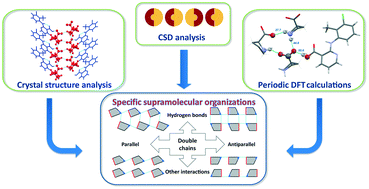Specific features of supramolecular organisation and hydrogen bonding in proline cocrystals: a case study of fenamates and diclofenac†
Abstract
New zwitterionic cocrystals of fenamate drugs and diclofenac with the naturally occurring amino acid L-proline have been obtained and thoroughly characterised by a variety of experimental and theoretical techniques. A crystal structure analysis and a CSD survey allowed us to establish a distinct supramolecular motif formed by the double chain arrangement of proline entities, which was found to play the structure-directing role in the proline zwitterionic cocrystals. Special graph set notation has been introduced to describe the particular type of the bifurcated H-bond observed in the crystal structures of proline with different APIs. Solid state DFT calculations enabled us to quantify different intermolecular interactions in the new cocrystals obtained, to interpret specific features of supramolecular organisation, and to explain the reasons for selective cocrystallisation of L-proline with fenamates. Cocrystallisation of the diclofenac and fenamate APIs with L-proline improved the solubility of these drugs in comparison with the parent drugs. The cocrystal solubility advantage values determined from eutectic concentrations at pH 6.8 and 25.0 °C were found to be in the range from 9 to 25.



 Please wait while we load your content...
Please wait while we load your content...